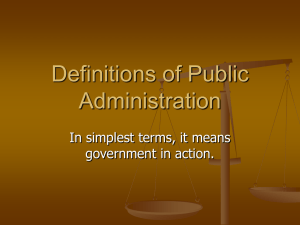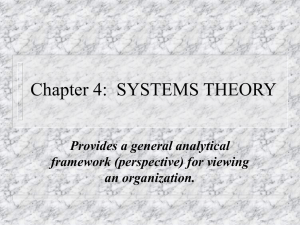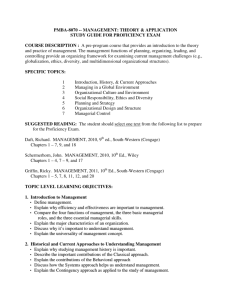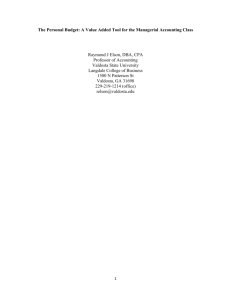Session 2 1.4 Levels of Strategic Planning After you've decided that
advertisement
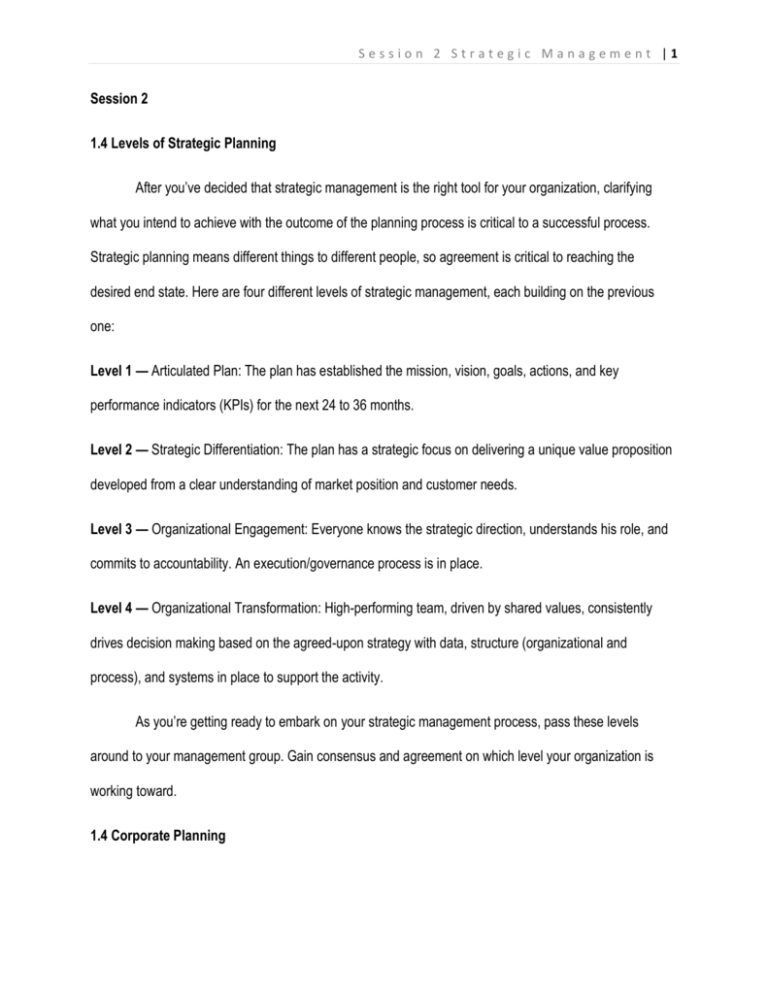
Session 2 Strategic Management |1 Session 2 1.4 Levels of Strategic Planning After you’ve decided that strategic management is the right tool for your organization, clarifying what you intend to achieve with the outcome of the planning process is critical to a successful process. Strategic planning means different things to different people, so agreement is critical to reaching the desired end state. Here are four different levels of strategic management, each building on the previous one: Level 1 — Articulated Plan: The plan has established the mission, vision, goals, actions, and key performance indicators (KPIs) for the next 24 to 36 months. Level 2 — Strategic Differentiation: The plan has a strategic focus on delivering a unique value proposition developed from a clear understanding of market position and customer needs. Level 3 — Organizational Engagement: Everyone knows the strategic direction, understands his role, and commits to accountability. An execution/governance process is in place. Level 4 — Organizational Transformation: High-performing team, driven by shared values, consistently drives decision making based on the agreed-upon strategy with data, structure (organizational and process), and systems in place to support the activity. As you’re getting ready to embark on your strategic management process, pass these levels around to your management group. Gain consensus and agreement on which level your organization is working toward. 1.4 Corporate Planning Session 2 Strategic Management |2 Corporate planning defines the strategies that the employees will take to meet the business’ goals and missions. This type of planning, also known as strategic planning, focuses on staff responsibilities and procedures. As with business planning, strategic planning requires a close look at the company’s missions, strengths and weaknesses. However, corporate planning identifies the step-by-step process of the business, such as the actual steps the staff will take to counteract challenges, train employees and achieve accomplishments. Corporate planning also provides specific, measurable goals with realistic time lines. 1.4.2. Enterprise Level Planning or business strategy Business strategy—this strategy seeks to determine how an organization should compete in each of its businesses. For a small organization in only one line of business or the large organization that has not diversified into different products or markets, the business strategy typically overlaps with the organization’s corporate strategy. For organizations with multiple businesses, however, each division will have its own strategy that defines the products or services it will offer and the customers it wants to reach. 1.4.3. Functional level planning The success of an organization largely depends on strategic management. Different level of strategic management plays different roles. During the 1970’s many organizations adopted top-down strategic planning for the survival of an organization. Once higher level strategies are developed, the next task of the management is to formulate and implement strategies for each functional area. Strategies are formulated on three different levels: Corporate level Business unit level Functional level Session 2 Strategic Management |3 To run an organization successfully it is essential to plan a strategy at each level but to gain maximum benefit of planning it is important to align the plans at every level. Without alignment department functions will contradict each other’s purpose and the overall corporate strategy will become less effective. No matter how well corporate level strategies are designed and formulated but if the execution of corporate level strategy fails in meeting the expected standard all the effort will go in vain. The success of strategy is largely determined at the functional level. Functional level checks the reality of corporate level and business level strategy and brings the desired result by turning strategies and planning into realities. The functional level of your organization is the level of the operating divisions and departments. It is the responsibility of the strategist to provide direction to functional managers regarding the execution of plan and strategies for the successful implementation. The role of functional strategy is very crucial for the existence of an organization. Functional strategy provides support to overall business strategy and secondly it spells out as to how functional managers will proceed to achieve the set goals and objectives. Departments like marketing, finance, production and HR are based on the functional capabilities of an organization. Within functional strategies there might be several sub-level areas. Functional strategies are planned keeping in mind the higher level strategies. In terms of level of strategy formulation functional strategy falls below business-level strategies. The development plan of functional strategies is conceived and designed by top-level management. Strategist manager plans executable functional strategies. Functional strategies support the overall business and corporate level business. Functional strategies are formulated by specialists in each area. It outlines the action plan and sets the milestones that are needed to achieve before reaching to the final goal of corporate strategy. Session 2 Strategic Management |4 Functional strategies work as a backbone of the organization. It provides the basic information on resources and capabilities on which the higher level strategy is designed. It involves coordinating the various functions and operations needed to design, manufacture, deliver, and support the product or service of each business within the corporate portfolio. Functional level strategy executes the plan developed at a higher level for the growth and advancement of an organization. Functional strategies are primarily concerned with: Efficiently utilizing specialists within the functional area. Integrating activities within the functional area (e.g., coordinating advertising, promotion, and marketing research in marketing; or purchasing, inventory control, and shipping in production/operations). Assuring that functional strategies mesh with business-level strategies and the overall corporatelevel strategy. The success of functional strategy is highly affected by the time factor. For example advertising of a new product is launched 60 days prior to shipment of the first product. Functional strategies have a shorter time span than business-level or corporate –level strategies. The task of functional unit of any organization is to formulate higher level strategies by providing input into the business unit level and corporate level strategy. Processing the available information and using it for higher level strategy formulation. Once the higher level strategies are developed, the function unit starts making executable action plans for each department. The strategic planner knows the relevance and significance of planning at different levels and how it helps the organization in achieving its objectives. The purpose of strategies and planning are to guide organizations in achieving its goals. Session 2 Strategic Management |5 Such as providing information on customer feedback or on resources and capabilities on which the higher level strategies can be based. Once the higher level strategy or strategic intent is developed, the functional units translate them into discrete action plans that each department or division must accomplish for the strategy to succeed. A good strategist draws a strategy using all the available resources and gets maximum benefits from its resources. 1.5. Strategic management organization Key Concepts for Strategic Management and Organizational Goals Strategic management is the process in which an organization develops and implements plans that espouse the goals and objectives of that organization. The process of strategic management is a continuous one that changes as the organizational goals and objectives evolve. Small businesses engage in strategic management to ensure that they adapt to trends and external changes such as globalization. Several key concepts characterize strategic management and the development of organizational goals. a) Goal Setting At the core of the strategic management process is the creation of goals, a mission statement, values and organizational objectives. Organizational goals, the mission statement, values and objectives guide the organization in its pursuit of strategic opportunities. It is also through goal setting that managers make strategic decisions such as how to meet sales targets and higher revenue generation. Through goal setting, organizations plan how to compete in an increasingly competitive and global business arena. b) Analysis Strategy Formation Analysis of an organization's strengths and weaknesses is a key concept of strategic management. Other than the internal analysis, an organization also undertakes external analysis of factors such as Session 2 Strategic Management |6 emerging technology and new competition. Through internal and external analysis, the organization creates goals and objectives that will turn weaknesses to strengths. The analyses also facilitate in strategizing ways of adapting to changing technology and emerging markets. c) Strategy Formation Strategy formation is a concept that entails developing specific actions that will enable an organization to meet its goals. Strategy formation entails using the information from the analyses, prioritizing and making decisions on how to address key issues facing the organization. Additionally, through strategy formulation an organization seeks to find ways of maximizing profitability and maintaining a competitive advantage. d) Strategy Implementation Strategy implementation is putting the actual strategy into practice to meet organizational goals. The idea behind this concept is to gather all the available and necessary resources required to bring the strategic plan to life. Organizations implement strategies through creating budgets, programs and policies to meet financial, management, human resources and operational goals. For the successful implementation of a strategic plan, cooperation between management and other personnel is absolutely necessary. e) Strategy Monitoring A final concept is monitoring of the strategy after its implementation. Strategy monitoring entails evaluating the strategy to determine if it yields the anticipated results as espoused in the organizational goals. Here, an organization determines what areas of the plan to measure and the methods of measuring these areas, and then compares the anticipated results with the actual ones. Through monitoring, an organization is able to understand when and how to adjust the plan to adapt to changing trends. 1.6. Strategic Direction Session 2 Strategic Management |7 Strategic direction can be defined as a course of action that ultimately leads to the achievement of the stated goals of a business or organizational strategy. Strategic direction is established during the strategic planning phase of an organization. During the strategic planning process an organization will create a strategic business plan and establish a written vision and mission statement. A strategic business plan differs from a business plan in that the strategic plan focuses on objectives, values, focus areas and performance indicators while a business plan focuses on functions of business that refer back to strategic direction. 1.7. Management control Strategies Where management control is imposed, it functions within the framework established by the strategy. Normally these objectives (standards) are established for major subsystems within the organization, such as SBUs, projects, products, functions, and responsibility centers. Typical management control measures include ROI, residual income, cost, product quality, and so on. These control measures are essentially summations of operational control measures. Corrective action may involve very minor or very major changes in the strategy. Operational control systems are designed to ensure that day-to-day actions are consistent with established plans and objectives. It focuses on events in a recent period. Operational control systems are derived from the requirements of the management control system. Corrective action is taken where performance does not meet standards. This action may involve training, motivation, leadership, discipline, or termination. The differences between strategic and operational control are highlighted by reference to a general definition of management control: "Management control is the set of measurement, analysis, and action Session 2 Strategic Management |8 decisions required for the timely management of the continuing operation of a process". This section discusses in the terms presented. Strategic control requires data from more sources. The typical operational control problem uses data from very few sources. Strategic control requires more data from external sources. Strategic decisions are normally taken with regard to the external environment as opposed to internal operating factors. Strategic control is oriented to the future. This is in contrast to operational control decisions in which control data give rise to immediate decisions that have immediate impacts. Strategic control is more concerned with measuring the accuracy of the decision premise. Operating decisions tend to be concerned with the quantitative value of certain outcomes. Strategic control standards are based on external factors. Measurement standards for operating problems can be established fairly by past performance on similar products or by similar operations currently being performed. Strategic control relies on variable reporting interval. The typical operating measurement is concerned with operations over some period of time: pieces per week, profit per quarter, and the like. Strategic control models are less precise. This is in contrast to operational control models, which are generally very precise in the narrow domain they apply. Strategic control models are less formal. The models that govern the considerations in a strategic control problem are much more intuitive, therefore, less formal. The principal variables in a strategic control model are structural. In strategic control, the whole structure of the problem, as represented by the model, is likely to vary, not just the values of the parameters. Session 2 Strategic Management |9 The key need in analysis for strategic control is model flexibility. This is in contrast to operating control, for which efficient quantitative computation is usually most desirable. The key activity in management control analysis is alternative generation. This is different from the operational control problem, in which in many cases all control alternatives have been specified in advance. The key analysis step in operations is to discover exactly what happened. The key skill required for management control analysis is creativity. In operational control, by contrast, the formal review of outcomes to discover causes means that they skill required is the ability to do technical, even statistical, analysis of the data received. The relationship between action and outcome is weaker in strategic control. This is not surprising, as the most desirable area for control in strategic problems -the environment -is the least subject to direct action. The key action variables in strategic control are organizational. In the operational control problem, technical factors such as labor levels, production levels, choice of materials, and the like are the predominant control levels. Alternative actions in strategic control are less easy to choose in advance. In strategic control problem, it is possible to choose all possible action responses to received data in advance. In an operational control problem, the few responses possible can usually all be worked out before any operating data received. The worst failing in strategic control is omitting a worthwhile action. In operating control, the most typical sins are those of omissions (e.g., complaints about too many people employed, too many defects, and too much inventory). In the strategic control problem, sins of omission are much more serious (e.g., not moving into a business opportunity when it presents itself, not undertaking a particular social program, not applying resources to meet that challenges in the best fashion). S e s s i o n 2 S t r a t e g i c M a n a g e m e n t | 10 The time for strategic control is longer. The period in which control has an impact is longer for strategic problems that for operating problems. The timing of strategic control is events oriented. By contrast, operating decisions tend to be made on a periodic basis, and they are usually measured accordingly. Strategic control has little repetition. Not even the structure is the same as past problems of a like kind, much less the technical details. Operating problems, by way of contrast, tend to repeat their structure. Strategic control requires a greater variety of data types. Operating control problems typically have a smaller variety of data. The total volume of data required for strategic control is smaller. On the other hand, perhaps thousands of pieces of data of each type are required for some of operating problems (e.g., the payroll processing of even a small organization). Strategic control data are more aggregated. Operating data are used at the most detailed at transaction level. Strategic control data are less accurate. Operating data generally need to be as accurate as possible. The most important strategic control information is structural. Unlike the operational control are, the values of the technical variables are only of secondary importance. The receipt of data for strategic control is more sporadic. Data for strategic problems are received sporadically as events take place. Strategic control data are less process able by computer. The strategic controls that arise in the environment rather than within the organization are generally not so easily available. For the most S e s s i o n 2 S t r a t e g i c M a n a g e m e n t | 11 part, such data need not be computerized. It does imply that any computerization of strategic control tools must consider the important step of capturing necessary in machine-readable form. The key decision in information for strategic control is what data to save. The principal problem in operating control information systems design is the technological problem of efficiently capturing and retrieving data. Contingency plans are less possible in strategic control. The whole idea of contingency plans is much more difficult in the strategic arena. It is more difficult to generate all possible actions ahead of time in a strategic problem, because the alternatives are too numerous and too complex. Triggering contingency planning is more important in strategic control. Because of this difficulty in making contingency plans, triggering an examination of alternatives when things do not go according to plan becomes much more important. Preprogrammed variance analysis is less possible in strategic control. For an operational control model might be possible that the computer performs all possible variance analyses (in the accounting sense). For strategic control it is both difficult technically and impossible practically. A variance inquiry system is more necessary in strategic control. It seems important to have an inquiry system linked to the formal planning model with which combinations of deviations from plans can be explored by the human operator. A variance inquiry language is more necessary in strategic control. Some sort of language in which the human can do variance inquiries is highly desirable in the area of strategic control. An augmented formal planning system in more necessary in strategic control. A formal planning system should be augmented with the variance inquiry language described. This would permit the same system that was used to generate the plan to be used in controlling that plan, leading to both ease of additional analysis as well, as to consistency with the plan being controlling. S e s s i o n 2 S t r a t e g i c M a n a g e m e n t | 12 An organization's effectiveness is in major part a measure of the effectiveness of its master strategy. Selection of the appropriate basis for assessing organizational effectiveness presents a challenging problem for managers and researchers. There are no generally accepted conceptualizations prescribing the best criteria. Different organizational situations - pertaining to the performance of the organization's structure, the performance of the organization's human resources, and the impact of the organization's activities -require different criteria. J. Barton Cunningham, after reviewing the relevant literature, concluded that seven major ways of evaluating organizational effectiveness existed: rational goal model, systems resource model, managerial process model, organizational development model, the bargaining model. The rational goal approach focuses on the organization's ability to achieve its goals. An organization's goals are identified by establishing the general goal, discovering means or objectives for its accomplishment, and defining a set of activities for each objective. The organization is evaluated by comparing the activities accomplished with those planned for. These criteria are determined by various factors. The systems resource model analyzes the decision-makers’ capability to efficiently distribute resources among various subsystem's needs. The systems resources model defines the organization as a network of interrelated subsystems. These subsystems needs may be classified as: Arraigning position -ability of the organization to exploit its environment in acquisition of scarce and valued resources. S e s s i o n 2 S t r a t e g i c M a n a g e m e n t | 13 Ability of the systems' decision-makers to perceive, and correctly interpret, the real properties of the external environment. ability of the system to produce a certain specified output. maintenance of internal day-to-day activities. ability of the organization to co-ordinate relationships among the various subsystems. ability of the organization to respond to feedback regarding its effectiveness in the environment. ability of the organization to evaluate the effect of its decisions. ability of the organization' system to accomplish its goals. Each organizational problem requires a specific allocation of resources. The bargaining model presumes that an organization is a cooperative, sometimes competitive, resource distributing system. Decisions, problems and goals are more useful when shared by a greater number of people. Each decision-maker bargains with other groups for scarce resources which are vital in solving problems and meeting goals. The overall outcome is a function of the particular strategies selected by the various decisionmakers in their bargaining relationships. This model measures the ability of decision-makers to obtain and use resources for responding to problems important to them. Each of the subsystems' needs should be evaluated from two focal points: efficiency and stress. Efficiency is an indication of the organization's ability to use its resources in responding to the most subsystems' needs. Stress is the tension produced by the system in fulfilling or not fulfilling its needs. The managerial process model assesses the capability and productivity of various managerial processes -decision making, planning, budgeting, and the like -for performing goals. S e s s i o n 2 S t r a t e g i c M a n a g e m e n t | 14 The managerial process model is based on the intuitive concept of substantial rationality, which interrelates the drives, impulses, wishes, feelings, needs, and values of the individuals to the functional goals of the organization. This model appraises the organization's ability to work as a team and to fit the needs of its members. The model focuses on developing practices to foster: 1. Supervisory behavior manifesting interest and concern for workers. 2. Team spirit, group loyalty, and teamwork among workers and between workers and management. 3. Confidence, trust and communication among workers and between workers and management. 4. More freedom to set their own objectives. The model's procedure attempts to answer four main questions: 1. Where are we?; 2. Where do we want to go?; 3. How will we get there?; 4. How will we know when we do get there? These questions can be divided into four areas: question one is concerned with diagnosis, question two with the setting of goals and plans, question three with the implementation of goals, and question four with evaluation. This model is concerned with changing beliefs, attitudes, values, and organizational structures so that individuals can be better adopt to new technologies and challenges. It is a process of management by objectives in contrast to management by control. S e s s i o n 2 S t r a t e g i c M a n a g e m e n t | 15 The structural functional approach tests the durability and flexibility of the organization's structure for responding to a diversity of situations and events. According to this model, all systems need maintenance and continuity. The following aspects define this: Security of the organization as whole in relation to the social forces in its environment (this relates to ability to forestall threatened aggressions or deleterious consequences from the actions of others); Stability of lines of authority and communication (this refers to the continued capacity of leadership to control and have access to individuals in the system); Stability of informal relations within the organization; Continuity of policy making (this refers to the ability to reexamine policy and a continuing basis); Homogeneity of outlook (this refers the ability to effectively orient members to organization norms and beliefs). In the functional approach an organization's effectiveness is determined by the social consequences of its activities. The crucial question to be answered is: how well do the organization's activities serve the needs of its client groups? The appraisal of an organization's effectiveness should consider whether these activities are function or dysfunctions in filling the organization's goals. These seven models have their strengths and shortcomings depending upon the organizational situation being evaluated. The choice of evaluation approach usually hinges on the organizational situation that needs to be addressed. S e s s i o n 2 S t r a t e g i c M a n a g e m e n t | 16 Until 1965, and not uncommonly even today, conventional wisdom held that planning and control in organizations should be separated: "... control must reflect plans; and planning must precede control". In 1965, Robert Anthony of the Harvard Business School put forward a novel framework for the analysis of planning and control systems. Anthony's basic thesis is that planning and control are so closely interlinked in organizations as to make their separation meaningless and undesirable. He suggests, it makes much more conceptual and practical sense to link together similar and intertwined planning and control activities into systems of homogeneous characteristics.



